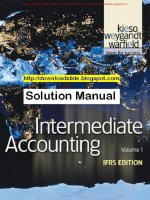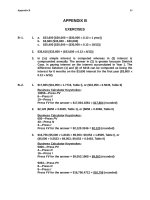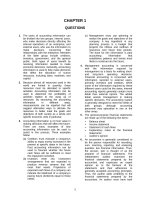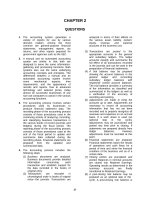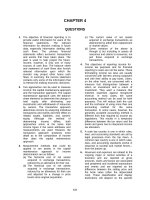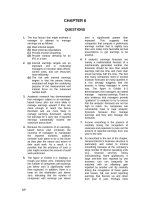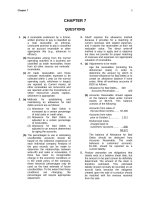Solution manual intermediate accounting 7th by nelson spiceland ch06
Bạn đang xem bản rút gọn của tài liệu. Xem và tải ngay bản đầy đủ của tài liệu tại đây (332.32 KB, 35 trang )
Find more slides, ebooks, solution manual and testbank on www.downloadslide.com
Chapter 6
Time Value of Money Concepts
QUESTIONS FOR REVIEW OF KEY TOPICS
Question 6-1
Interest is the amount of money paid or received in excess of the amount borrowed or lent.
Question 6-2
Compound interest includes interest not only on the original invested amount but also on the
accumulated interest from previous periods.
Question 6-3
If interest is compounded more frequently than once a year, the effective rate or yield will be
higher than the annual stated rate.
Question 6-4
The three items of information necessary to compute the future value of a single amount are
the original invested amount, the interest rate (i) and the number of compounding periods (n).
Question 6-5
The present value of a single amount is the amount of money today that is equivalent to a given
amount to be received or paid in the future.
Question 6-6
Monetary assets and monetary liabilities represent cash or fixed claims/commitments to
receive/pay cash in the future and are valued at the present value of these fixed cash flows. All other
assets and liabilities are nonmonetary.
Question 6-7
An annuity is a series of equal-sized cash flows occurring over equal intervals of time.
Question 6-8
An ordinary annuity exists when the cash flows occur at the end of each period. In an annuity
due the cash flows occur at the beginning of each period.
Question 6-9
Table 2 lists the present value of $1 factors for various time periods and interest rates. The
factors in Table 4 are simply the summation of the individual PV of $1 factors from Table 2.
Solutions Manual, Vol.1, Chapter 6
© The McGraw-Hill Companies, Inc., 2007
6-1
Find more slides, ebooks, solution manual and testbank on www.downloadslide.com
Answers to Questions (continued)
Question 6-10
Present
Value
?
0
Year 1
Year 2
Year 3
Year 4
___________________________________________
$200
$200
$200
n = 4, i = 10%
$200
Question 6-11
Present
Value
?
0
Year 1
Year 2
Year 3
Year 4
___________________________________________
$200
$200
$200
$200
n = 4, i = 10%
Question 6-12
A deferred annuity exists when the first cash flow occurs more than one period after the date
the agreement begins.
Question 6-13
The formula for computing present value of an ordinary annuity incorporating the ordinary
annuity factors from Table 4 is:
PVA = Annuity amount x Ordinary annuity factor
Solving for the annuity amount,
PVA
Annuity amount =
Ordinary annuity factor
The annuity factor can be obtained from Table 4 at the intersection of the 8% column and 5
period row.
Question 6-14
Annuity amount =
Annuity amount =
$500
3.99271
$125.23
© The McGraw-Hill Companies, Inc., 2007
6-2
Intermediate Accounting, 4/e
Find more slides, ebooks, solution manual and testbank on www.downloadslide.com
Answers to Questions (concluded)
Question 6-15
Companies frequently acquire the use of assets by leasing rather than purchasing them. Leases
usually require the payment of fixed amounts at regular intervals over the life of the lease. Certain
long-term, noncancelable leases are treated in a manner similar to an installment sale by the lessor
and an installment purchase by the lessee. In other words, the lessor records a receivable and the
lessee records a liability for the several installment payments. For the lessee, this requires that the
leased asset and corresponding lease liability be valued at the present value of the lease payments.
Solutions Manual, Vol.1, Chapter 6
© The McGraw-Hill Companies, Inc., 2007
6-3
Find more slides, ebooks, solution manual and testbank on www.downloadslide.com
BRIEF EXERCISES
Brief Exercise 6-1
Fran should choose the second investment opportunity. More rapid compounding
has the effect of increasing the actual rate, which is called the effective rate, at which
money grows per year. For the second opportunity, there are four, three-month
periods paying interest at 2% (one-quarter of the annual rate). $10,000 invested will
grow to $10,824 ($10,000 x 1.0824*). The effective annual interest rate, often referred
to as the annual yield, is 8.24% ($824 ÷ $10,000), compared to just 8% for the first
opportunity.
* Future value of $1: n=4, i=2% (from Table 1)
Brief Exercise 6-2
Bill will not have enough accumulated to take the trip. The future value of his
investment of $23,153 is $347 short of $23,500.
FV = $20,000 (1.15763* ) = $23,153
* Future value of $1: n=3, i=5% (from Table 1)
Brief Exercise 6-3
FV factor =
$26,600 = 1.33*
$20,000
* Future value of $1: n=3, i=? (from Table 1, i = approximately 10%)
Brief Exercise 6-4
John would be willing to invest no more than $12,673 in this opportunity.
PV = $16,000 (.79209* ) = $12,673
* Present value of $1: n=4, i=6% (from Table 2)
© The McGraw-Hill Companies, Inc., 2007
6-4
Intermediate Accounting, 4/e
Find more slides, ebooks, solution manual and testbank on www.downloadslide.com
Brief Exercise 6-5
PV factor
= $13,200 = .825*
$16,000
* Present value of $1: n=4, i=? (from Table 2, i = approximately 5%)
Brief Exercise 6-6
Interest is paid for 12 periods at 1% (one-quarter of the annual rate).
FVA
= $500 (12.6825* )
= $6,341
* Future value of an ordinary annuity of $1: n=12, i=1% (from Table 3)
Brief Exercise 6-7
Interest is paid for 12 periods at 1% (one-quarter of the annual rate).
FVAD
= $500 (12.8093* )
= $6,405
* Future value of an annuity due of $1: n=12, i=1% (from Table 5)
Brief Exercise 6-8
PVA
= $10,000 (4.10020* )
= $41,000 approximately
* Present value of an ordinary annuity of $1: n=5, i=7% (from Table 4)
Solutions Manual, Vol.1, Chapter 6
© The McGraw-Hill Companies, Inc., 2007
6-5
Find more slides, ebooks, solution manual and testbank on www.downloadslide.com
Brief Exercise 6-9
PVAD
= $10,000 (4.38721*)
= $43,872
* Present value of an annuity due of $1: n=5, i=7% (from Table 6)
Brief Exercise 6-10
PVA = $10,000
x
4.10020*
=
$41,002
* Present value of an ordinary annuity of $1: n=5, i=7% (from Table 4)
PV
= $41,002
x
.87344*
=
$35,813
* Present value of $1: n=2, i=7% (from Table 2)
Or alternatively:
From Table 4,
PVA factor, n=7, i=7%
– PVA factor, n=2, i=7%
= PV factor for deferred annuity
PV
=
=
=
5.38929
1.80802
3.58127
= $10,000 x 3.58127 = $35,813 (rounded)
Brief Exercise 6-11
Annuity
=
$100,000
6.71008*
= $14,903 = Payment
* Present value of an ordinary annuity of $1: n=10, i=8% (from Table 4)
© The McGraw-Hill Companies, Inc., 2007
6-6
Intermediate Accounting, 4/e
Find more slides, ebooks, solution manual and testbank on www.downloadslide.com
Brief Exercise 6-12
PV = $6,000,0001 (12.40904* ) + 100,000,000 (.13137** )
PV = $74,454,240 + 13,137,000 = $87,591,240 = price of the bonds
1
$100,000,000 x 6% = $6,000,000
* Present value of an ordinary annuity of $1: n=30, i=7% (from Table 4)
** Present value of $1: n=30, i=7% (from Table 2)
Brief Exercise 6-13
PVAD = $55,000 (7.24689* ) = $398,579 = Liability
* Present value of an annuity due of $1: n=10, i=8% (from Table 6)
Solutions Manual, Vol.1, Chapter 6
© The McGraw-Hill Companies, Inc., 2007
6-7
Find more slides, ebooks, solution manual and testbank on www.downloadslide.com
EXERCISES
Exercise 6-1
1. FV = $15,000 (2.01220* ) = $30,183
* Future value of $1: n=12, i=6% (from Table 1)
2. FV = $20,000 (2.15892* ) = $43,178
* Future value of $1: n=10, i=8% (from Table 1)
3. FV = $30,000 (9.64629* ) = $289,389
* Future value of $1: n=20, i=12% (from Table 1)
4. FV = $50,000 (1.60103* ) = $80,052
* Future value of $1: n=12, i=4% (from Table 1)
Exercise 6-2
1. PV = $20,000 (.50835* ) = $10,167
* Present value of $1: n=10, i=7% (from Table 2)
2. PV = $14,000 (.39711* ) = $5,560
* Present value of $1: n=12, i=8% (from Table 2)
3. PV = $25,000 (.10367* ) = $2,592
* Present value of $1: n=20, i=12% (from Table 2)
4. PV = $40,000 (.46651* ) = $18,660
* Present value of $1: n=8, i=10% (from Table 2)
Exercise 6-3
First payment:
Second payment
Third payment
Fourth payment
Payment
$5,000
6,000
8,000
9,000
Total
© The McGraw-Hill Companies, Inc., 2007
6-8
x
x
x
x
PV of $1
i=8%
.92593
.85734
.73503
.63017
=
=
=
=
PV
$ 4,630
5,144
5,880
5,672
$21,326
n
1
2
4
6
Intermediate Accounting, 4/e
Find more slides, ebooks, solution manual and testbank on www.downloadslide.com
Exercise 6-4
1. FV = $10,000 (2.65330* ) = $26,533
* Future value of $1: n=20, i=5% (from Table 1)
2. FV = $10,000 (1.80611* ) = $18,061
* Future value of $1: n=20, i=3% (from Table 1)
3. FV = $10,000 (1.81136* ) = $18,114
* Future value of $1: n=30, i=2% (from Table 1)
Exercise 6-5
1.
FVA
= $2,000 (4.7793* ) = $9,559
* Future value of an ordinary annuity of $1: n=4, i=12% (from Table 3)
2.
FVAD = $2,000 (5.3528* ) = $10,706
* Future value of an annuity due of $1: n=4, i=12% (from Table 5)
3.
First deposit:
Second deposit
Third deposit
Fourth deposit
4.
Deposit
$2,000
2,000
2,000
2,000
Total
x
x
x
x
FV of $1
i=3%
1.60471
1.42576
1.26677
1.12551
=
=
=
=
FV
$ 3,209
2,852
2,534
2,251
$10,846
n
16
12
8
4
$2,000 x 4 = $8,000
Solutions Manual, Vol.1, Chapter 6
© The McGraw-Hill Companies, Inc., 2007
6-9
Find more slides, ebooks, solution manual and testbank on www.downloadslide.com
Exercise 6-6
1.
PVA
= $5,000 (3.60478* )
= $18,024
* Present value of an ordinary annuity of $1: n=5, i=12% (from Table 4)
2.
PVAD = $5,000 (4.03735* )
= $20,187
* Present value of an annuity due of $1: n=5, i=12% (from Table 6)
3.
Payment
$5,000
5,000
5,000
5,000
5,000
Total
First payment:
Second payment
Third payment
Fourth payment
Fifth payment
x
x
x
x
x
PV of $1
i = 3%
.88849
.78941
.70138
.62317
.55368
=
=
=
=
=
PV
$ 4,442
3,947
3,507
3,116
2,768
$17,780
n
4
8
12
16
20
Exercise 6-7
1.
PV = $40,000 (.62092* ) = $24,837
* Present value of $1: n=5, i=10% (from Table 2)
2.
$36,289
$65,000
=
.55829*
* Present value of $1: n=10, i=? (from Table 2, i = approximately 6%)
3.
$15,884
$40,000
=
.3971*
* Present value of $1: n=?, i=8% (from Table 2, n = approximately 12 years)
4.
$46,651 =
$100,000
.46651*
* Present value of $1: n=8, i=? (from Table 2, i = approximately 10%)
5.
FV = $15,376 (3.86968* ) = $59,500
* Future value of $1: n=20, i=7% (from Table 1)
© The McGraw-Hill Companies, Inc., 2007
6-10
Intermediate Accounting, 4/e
Find more slides, ebooks, solution manual and testbank on www.downloadslide.com
Exercise 6-8
1.
PVA = $3,000 (3.99271* ) = $11,978
* Present value of an ordinary annuity of $1: n=5, i=8% (from Table 4)
2.
$242,980 =
$75,000
3.2397*
* Present value of an ordinary annuity of $1: n=4, i=? (from Table 4, i =
approximately 9%)
3.
$161,214 =
$20,000
8.0607*
* Present value of an ordinary annuity of $1: n=?, i= 9% (from Table 4, n =
approximately 15 years)
4.
$500,000 =
$80,518
6.20979*
* Present value of an ordinary annuity of $1: n=8, i=? (from Table 4, i =
approximately 6%)
5.
$250,000 =
3.16987*
$78,868
* Present value of an ordinary annuity of $1: n=4, i=10% (from Table 4)
Exercise 6-9
Requirement 1
PV = $100,000 (.68058* ) = $68,058
* Present value of $1: n=5, i=8% (from Table 2)
Requirement 2
Annuity amount = $100,000
5.8666*
* Future value of an ordinary annuity of $1: n=5, i=8% (from Table 3)
Annuity amount
= $17,046
Requirement 3
Annuity amount = $100,000
6.3359*
* Future value of an annuity due of $1: n=5, i=8% (from Table 5)
Annuity amount = $15,783
Solutions Manual, Vol.1, Chapter 6
© The McGraw-Hill Companies, Inc., 2007
6-11
Find more slides, ebooks, solution manual and testbank on www.downloadslide.com
Exercise 6-10
1. Choose the option with the highest present value.
(1) PV = $64,000
(2) PV = $20,000 + $8,000 (4.91732* )
* Present value of an ordinary annuity of $1: n=6, i=6% (from Table 4)
PV = $20,000 + $39,339 = $59,339
(3) PV = $13,000 (4.91732* ) = $63,925
Alex should choose option (1).
2. FVA = $100,000 (13.8164* ) = $1,381,640
* Future value of an ordinary annuity of $1: n=10, i=7% (from Table 3)
Exercise 6-11
PV = $85,000 (.82645* ) = $70,248 = Note/revenue
* Present value of $1: n=2, i=10% (from Table 2)
© The McGraw-Hill Companies, Inc., 2007
6-12
Intermediate Accounting, 4/e
Find more slides, ebooks, solution manual and testbank on www.downloadslide.com
Exercise 6-12
Annuity = $20,000 – 5,000 = $670 = Payment
22.39646*
* Present value of an ordinary annuity of $1: n=30, i=2% (from Table 4)
Exercise 6-13
PVA factor = $100,000 = 7.46938*
$13,388
* Present value of an ordinary annuity of $1: n=20, i=? (from Table 4, i =
approximately 12%)
Exercise 6-14
Annuity =
$12,000 = $734 = Payment
16.35143*
* Present value of an ordinary annuity of $1: n=20, i=2% (from Table 4)
5 years x 4 quarters = 20 periods
8% ÷ 4 quarters = 2%
Exercise 6-15
PV = $12,000,0001 (17.15909* ) + 300,000,000 (.14205** )
PV = $205,909,080 + 42,615,000 = $248,524,080 = price of the bonds
1
$300,000,000 x 4 % = $12,000,000
* Present value of an ordinary annuity of $1: n=40, i=5% (from Table 4)
** Present value of $1: n=40, i=5% (from Table 2)
Solutions Manual, Vol.1, Chapter 6
© The McGraw-Hill Companies, Inc., 2007
6-13
Find more slides, ebooks, solution manual and testbank on www.downloadslide.com
Exercise 6-16
PVA = $5,000
x
4.35526*
=
$21,776
* Present value of an ordinary annuity of $1: n=6, i=10% (from Table 4)
PV
= $21,776
x
.82645*
=
$17,997
* Present value of $1: n=2, i=10% (from Table 2)
Or alternatively:
From Table 4,
PVA factor, n=8, i=10%
– PVA factor, n=2, i=10%
= PV factor for deferred annuity
PV
=
=
=
5.33493
1.73554
3.59939
= $5,000 x 3.59939 = $17,997
Exercise 6-17
PV
=
PV
=
?
x
$1,200 =
.90573*
.90573*
=
1,200
$1,325
* Present value of $1: n=5, i=2% (from Table 2)
PVA =
?
x
14.99203*
=
$1,325
annuity amount
PVA =
$1,325
=
*
14.99203
$88
=
Payment
* Present value of an ordinary annuity of $1: n=18, i=2% (from Table 4)
Exercise 6-18
Requirement 1
PVA = $400,000 (10.59401* ) = $4,237,604 = Liability
* Present value of an ordinary annuity of $1: n=20, i=7% (from Table 4)
Requirement 2
PVAD = $400,000 (11.33560* ) = $4,534,240 = Liability
* Present value of an annuity due of $1: n=20, i=7% (from Table 6)
© The McGraw-Hill Companies, Inc., 2007
6-14
Intermediate Accounting, 4/e
Find more slides, ebooks, solution manual and testbank on www.downloadslide.com
Exercise 6-19
List A
e
1. Interest
m
2. Monetary asset
j
3. Compound interest
i
k
4. Simple interest
5. Annuity
l
6. Present value of a single
amount
7. Annuity due
c
d
a
8. Future value of a single
amount
9. Ordinary annuity
b
10. Effective rate or yield
h
g
11. Nonmonetary asset
12. Time value of money
f
13. Monetary liability
Solutions Manual, Vol.1, Chapter 6
List B
a. First cash flow occurs one period after agreement
begins.
b. The rate at which money will actually grow during a
year.
c. First cash flow occurs on the first day of the
agreement.
d. The amount of money that a dollar will grow to.
e. Amount of money paid/received in excess of amount
borrowed/lent.
f. Obligation to pay a sum of cash, the amount of
which is fixed.
g. Money can be invested today and grow to a larger
amount.
h. No fixed dollar amount attached.
i. Computed by multiplying an invested amount by the
interest rate.
j. Interest calculated on invested amount plus
accumulated interest.
k. A series of equal-sized cash flows.
l. Amount of money required today that is equivalent to
a given future amount.
m. Claim to receive a fixed amount of money.
© The McGraw-Hill Companies, Inc., 2007
6-15
Find more slides, ebooks, solution manual and testbank on www.downloadslide.com
Exercise 6-20
1. a. An annuity is a series of cash flows or other economic benefits occurring at
fixed intervals, ordinarily as a result of an investment. Present value is the
value at a specified time of an amount or amounts to be paid or received later,
discounted at some interest rate. In an annuity due, the payments occur at the
beginning, rather than at the end, of the periods. Thus, the present value of an
annuity due includes the initial payment at its undiscounted amount. This lease
should be evaluated using the present value of an annuity due.
2. d. Both future value tables will be used because the $75,000 already in the account
will be multiplied times the future value factor of 1.26 to determine the amount
3 years hence, or $94,500. The three payments of $4,000 represent an ordinary
annuity. Multiplying the three-period annuity factor (3.25) by the payment
amount ($4,000) results in a future value of the annuity of $13,000. Adding the
two elements together produces a total account balance of $107,500.
© The McGraw-Hill Companies, Inc., 2007
6-16
Intermediate Accounting, 4/e
Find more slides, ebooks, solution manual and testbank on www.downloadslide.com
PROBLEMS
Problem 6-1
Choose the option with the lowest present value of cash outflows, net of the
present value of any cash inflows (Cash outflows are shown as negative amounts; cash
inflows as positive amounts).
Machine A:
PV = – $48,000 – 1,000 (6.71008* ) + 5,000 (.46319** )
* Present value of an ordinary annuity of $1: n=10, i=8% (from Table 4)
** Present value of $1: n=10, i=8% (from Table 2)
PV = – $48,000 – 6,710 + 2,316
PV = – $52,394
Machine B:
PV = – $40,000 – 4,000 (.79383) – 5,000 (.63017) – 6,000 (.54027)
PV of $1: i=8%
(from Table 2)
n=3
n=6
n=8
PV = - $40,000 - 3,175 - 3,151 - 3,242
PV = - $49,568
Esquire should purchase machine B.
Problem 6-2
1. PV = $10,000 + 8,000 (3.79079* ) = $40,326 = Equipment
* Present value of an ordinary annuity of $1: n=5, i=10% (from Table 4)
2. $400,000 = Annuity amount x 5.9753*
* Future value of an annuity due of $1: n=5, i=6% (from Table 5)
Annuity amount = $400,000
5.9753
Annuity amount = $66,942 = Required annual deposit
3. PVAD = $120,000 (9.36492* ) = $1,123,790 = Lease liability
* Present value of an annuity due of $1: n=20, i=10% (from Table 6)
Solutions Manual, Vol.1, Chapter 6
© The McGraw-Hill Companies, Inc., 2007
6-17
Find more slides, ebooks, solution manual and testbank on www.downloadslide.com
Problem 6-3
Choose the option with the lowest present value of cash payments.
1. PV = $1,000,000
2. PV = $420,000 + 80,000 (6.71008* ) = $956,806
* Present value of an ordinary annuity of $1: n=10, i=8% (from Table 4)
3. PV = PVAD = $135,000 (7.24689* ) = $978,330
* Present value of an annuity due of $1: n=10, i=8% (from Table 6)
4. PV = $1,500,000 (.68058* ) = $1,020,870
* Present value of $1: n=5, i=8% (from Table 2)
Harding should choose option 2.
Problem 6-4
The restaurant should be purchased if the present value of the future cash
flows discounted at 10% rate is greater than $800,000.
PV = $80,000 (4.35526* ) + 70,000 (.51316** ) + 60,000 (.46651**)
n=8
n=7
+ $50,000 (.42410**) + 40,000 (.38554**) + 700,000 (.38554**)
n=9
n=10
n=10
* Present value of an ordinary annuity of $1: n=6, i=10% (from Table 4)
** Present value of $1:, i=10% (from Table 2)
PV = $718,838 < $800,000
Since the PV is less than $800,000, the restaurant should not be purchased.
© The McGraw-Hill Companies, Inc., 2007
6-18
Intermediate Accounting, 4/e
Find more slides, ebooks, solution manual and testbank on www.downloadslide.com
Problem 6-5
The maximum amount that should be paid for the store is the present value of the
estimated cash flows.
Years 1-5:
PVA = $70,000
x
3.99271* =
$279,490
* Present value of an ordinary annuity of $1: n=5, i=8% (from Table 4)
Years 6-10:
PVA = $70,000
x
3.79079* =
$265,355
* Present value of an ordinary annuity of $1: n=5, i=10% (from Table 4)
PV
= $265,355
x
.68058*
=
$180,595
=
$395,515
* Present value of $1: n=5, i=8% (from Table 2)
Years 11-20:
PVA = $70,000
x
5.65022*
* Present value of an ordinary annuity of $1: n=10, i=12% (from Table 4)
PV
= $395,515
x
.62092*
=
$245,583
=
$167,139
* Present value of $1: n=5, i=10% (from Table 2)
PV
= $245,583
x
.68058*
* Present value of $1: n=5, i=8% (from Table 2)
End of Year 20:
PV
= $400,000
x
.32197* x .62092 x .68058 =
$54,424
* Present value of $1: n=10, i=12% (from Table 2)
Total PV = $279,490 + 180,595 + 167,139 + 54,424 =
$681,648
The maximum purchase price is $681,648.
Solutions Manual, Vol.1, Chapter 6
© The McGraw-Hill Companies, Inc., 2007
6-19
Find more slides, ebooks, solution manual and testbank on www.downloadslide.com
Problem 6-6
1.
PV of $1 factor = $30,000 = .5000*
$60,000
* Present value of $1: n=? , i=8% (from Table 2, n = approximately 9 years)
2.
Annuity factor =
PVA
Annuity amount
Annuity factor = $28,700 = 4.1000*
$7,000
* Present value of an ordinary annuity of $1: n= 5, i=? (from Table 4, i =
approximately 7%)
3.
PVA
Annuity amount = Annuity factor
Annuity amount = $10,000 =
6.41766*
$1,558
=
Payment
* Present value of an ordinary annuity of $1: n=10, i=9% (from Table 4)
© The McGraw-Hill Companies, Inc., 2007
6-20
Intermediate Accounting, 4/e
Find more slides, ebooks, solution manual and testbank on www.downloadslide.com
Problem 6-7
Requirement 1
PVA
Annuity amount = Annuity factor
Annuity amount = $250,000 = $78,868 = Payment
3.16987*
* Present value of an ordinary annuity of $1: n=4, i=10% (from Table 4)
Requirement 2
PVA
Annuity amount = Annuity factor
Annuity amount = $250,000 = $62,614 = Payment
3.99271*
* Present value of an ordinary annuity of $1: n=5, i=8% (from Table 4)
Requirement 3
PVA
Annuity factor = Annuity amount
Annuity factor = $250,000 = 4.86845*
$51,351
* Present value of an ordinary annuity of $1: n=? , i= 10% (from Table 4, n = approximately 7
payments)
Requirement 4
PVA
Annuity factor = Annuity amount
Annuity factor = $250,000 = 2.40184*
$104,087
* Present value of an ordinary annuity of $1: n= 3, i= ? (from Table 4, i = approximately
12%)
Solutions Manual, Vol.1, Chapter 6
© The McGraw-Hill Companies, Inc., 2007
6-21
Find more slides, ebooks, solution manual and testbank on www.downloadslide.com
Problem 6-8
Requirement 1
Present value of payments 4-6:
PVA = $40,000
x
2.48685*
=
$99,474
* Present value of an ordinary annuity of $1: n= 3, i= 10% (from Table 4)
PV
= $99,474
x
.75131*
=
$74,736
* Present value $1: n= 3, i= 10% (from Table 2)
Present value of all payments:
$ 62,171 (PV of payments 1-3: $25,000
74,736
$136,907
x
2.48685* )
(PV of payments 4-6 calculated above)
The note payable and corresponding building should be recorded at $136,907.
Or alternatively:
PV = $25,000 (2.48685* ) + 40,000 (1.86841** ) = $136,907
* Present value of an ordinary annuity of $1: n=3, i=10% (from Table 4)
From Table 4,
PVA factor, n=6, i=10%
– PVA factor, n=3 i=10%
= PV factor for deferred annuity
= 4.35526
= 2.48685
= 1.86841**
Requirement 2
$136,907 x 10% = $13,691 = Interest in the year 2006
© The McGraw-Hill Companies, Inc., 2007
6-22
Intermediate Accounting, 4/e
Find more slides, ebooks, solution manual and testbank on www.downloadslide.com
Problem 6-9
Choose the alternative with the highest present value.
Alternative 1:
PV = $180,000
Alternative 2:
PV = PVAD = $16,000 (11.33560* ) = $181,370
* Present value of an annuity due of $1: n=20, i=7% (from Table 6)
Alternative 3:
PVA = $50,000
x
7.02358*
=
$351,179
* Present value of an ordinary annuity of $1: n=10, i=7% (from Table 4)
PV
= $351,179
x
.54393*
=
$191,017
* Present value of $1: n=9, i=7% (from Table 2)
John should choose alternative 3.
Or, alternatively (for 3):
PV = $50,000 (3.82037* )
=
$191,019
(difference due to rounding)
From Table 4,
PVA factor, n=19, i=7%
– PVA factor, n=9, i=7%
= PV factor for deferred annuity
= 10.33560
= 6.51523
= 3.82037*
or, From Table 6,
PVAD factor, n=20, i=7%
— PVAD factor, n=10, i=7%
= PV factor for deferred annuity
Solutions Manual, Vol.1, Chapter 6
= 11.33560
= 7.51523
= 3.82037*
© The McGraw-Hill Companies, Inc., 2007
6-23
Find more slides, ebooks, solution manual and testbank on www.downloadslide.com
Problem 6-10
PV = $20,000 (3.79079* ) + 100,000 (.62092** ) = $137,908
* Present value of an ordinary annuity of $1: n=5, i=10% (from Table 4)
** Present value of $1: n=5, i=10% (from Table 2)
The note payable and corresponding merchandise should be recorded at $137,908.
© The McGraw-Hill Companies, Inc., 2007
6-24
Intermediate Accounting, 4/e
Find more slides, ebooks, solution manual and testbank on www.downloadslide.com
Problem 6-11
Requirement 1
PVAD = Annuity amount x Annuity factor
Annuity amount =
PVAD
Annuity factor
Annuity amount = $800,000
7.24689*
* Present value of an annuity due of $1: n=10, i=8% (from Table 6)
Annuity amount = $110,392 = Lease payment
Requirement 2
Annuity amount = $800,000
6.71008*
* Present value of an ordinary annuity of $1: n=10, i=8% (from Table 4)
Annuity amount = $119,224 = Lease payment
Requirement 3
PVAD = (Annuity amount x Annuity factor) + PV of residual
Annuity amount =
PVAD – PV of residual
Annuity factor
PV of residual = $50,000
x
.46319*
=
$23,160
* Present value of $1: n=10, i=8% (from Table 2)
Annuity amount = $800,000 – 23,160
7.24689*
* Present value of an annuity due of $1: n=10, i=8% (from Table 6)
Annuity amount = $107,196 = Lease payment
Solutions Manual, Vol.1, Chapter 6
© The McGraw-Hill Companies, Inc., 2007
6-25
